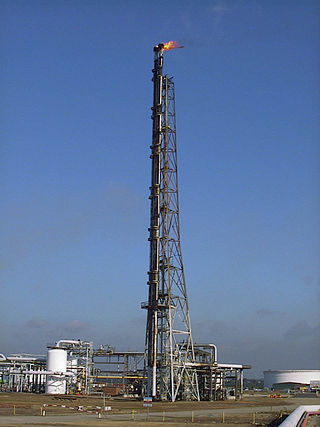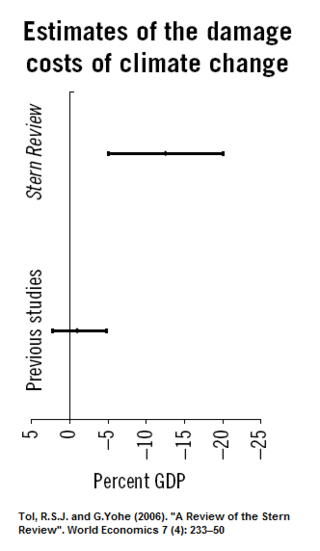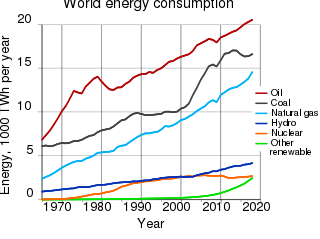Related Research Articles

Global warming potential or greenhouse warming potential (GWP) is a measure of how much infrared thermal radiation a greenhouse gas added to the atmosphere would absorb over a given time frame, as a multiple of the radiation that would be absorbed by the same mass of added carbon dioxide. GWP is 1 for CO2. For other gases it depends on how strongly the gas absorbs infrared thermal radiation, how quickly the gas leaves the atmosphere, and the time frame being considered. The carbon dioxide equivalent is calculated from GWP. For any gas, it is the mass of CO2 that would warm the earth as much as the mass of that gas. Thus it provides a common scale for measuring the climate effects of different gases. It is calculated as GWP times mass of the other gas.

Infant mortality is the death of an infant before the infant's first birthday. The occurrence of infant mortality in a population can be described by the infant mortality rate (IMR), which is the number of deaths of infants under one year of age per 1,000 live births. Similarly, the child mortality rate, also known as the under-five mortality rate, compares the death rate of children up to the age of five.

There is a strong scientific consensus that the Earth is warming and that this warming is mainly caused by human activities. This consensus is supported by various studies of scientists' opinions and by position statements of scientific organizations, many of which explicitly agree with the Intergovernmental Panel on Climate Change (IPCC) synthesis reports.

Preterm birth, also known as premature birth, is the birth of a baby at fewer than 37 weeks gestational age, as opposed to full-term delivery at approximately 40 weeks. Extreme preterm is less than 28 weeks, very early preterm birth is between 28 and 32 weeks, early preterm birth occurs between 32 and 34 weeks, late preterm birth is between 34 and 36 weeks' gestation. These babies are also known as premature babies or colloquially preemies or premmies. Symptoms of preterm labor include uterine contractions which occur more often than every ten minutes and/or the leaking of fluid from the vagina before 37 weeks. Premature infants are at greater risk for cerebral palsy, delays in development, hearing problems and problems with their vision. The earlier a baby is born, the greater these risks will be.
Environmental toxicants and fetal development is the impact of different toxic substances from the environment on the development of the fetus. This article deals with potential adverse effects of environmental toxicants on the prenatal development of both the embryo or fetus, as well as pregnancy complications. The human embryo or fetus is relatively susceptible to impact from adverse conditions within the mother's environment. Substandard fetal conditions often cause various degrees of developmental delays, both physical and mental, for the growing baby. Although some variables do occur as a result of genetic conditions pertaining to the father, a great many are directly brought about from environmental toxins that the mother is exposed to.

Climate change affects the physical environment, ecosystems and human societies. Changes in the climate system include an overall warming trend, more extreme weather and rising sea levels. These in turn impact nature and wildlife, as well as human settlements and societies. The effects of human-caused climate change are broad and far-reaching. This is especially so if there is no significant climate action. Experts sometimes describe the projected and observed negative impacts of climate change as the climate crisis.

A gas flare, alternatively known as a flare stack, flare boom, ground flare, or flare pit, is a gas combustion device used in places such as petroleum refineries, chemical plants and natural gas processing plants, oil or gas extraction sites having oil wells, gas wells, offshore oil and gas rigs and landfills.

The economic analysis of climate change explains how economic thinking, tools and techniques are applied to calculate the magnitude and distribution of damage caused by climate change. It also informs the policies and approaches for mitigation and adaptation to climate change from global to household scales. This topic is also inclusive of alternative economic approaches, including ecological economics and degrowth. In a cost–benefit analysis, the trade offs between climate change impacts, adaptation, and mitigation are made explicit. Cost–benefit analyses of climate change are produced using integrated assessment models (IAMs), which incorporate aspects of the natural, social, and economic sciences. The total economic impacts from climate change are difficult to estimate, but increase for higher temperature changes.

Air pollution is the contamination of air due to the presence of substances in the atmosphere that are harmful to the health of humans and other living beings, or cause damage to the climate or to materials. It is also the contamination of indoor or outdoor surrounding either by chemical activities, physical or biological agents that alters the natural features of the atmosphere. There are many different types of air pollutants, such as gases, particulates, and biological molecules. Air pollution can cause diseases, allergies, and even death to humans; it can also cause harm to other living organisms such as animals and crops, and may damage the natural environment or built environment. Air pollution can be caused by both human activities and natural phenomena.

Jonathan Evan Fielding is a board-certified physician in both Pediatrics and Preventive Medicine, and the former director and health officer of the Los Angeles County Department of Public Health. At UCLA, he is a Distinguished Professor in the Fielding School of Public Health and a Professor in the David Geffen School of Medicine. He is the founder and co-director of the UCLA Center for Health Advancement in the UCLA Fielding School of Public Health.

Pollution in California relates to the degree of pollution in the air, water, and land of the U.S. state of California. Pollution is defined as the addition of any substance or any form of energy to the environment at a faster rate than it can be dispersed, diluted, decomposed, recycled, or stored in some harmless form. The combination of three main factors are the cause of notable unhealthy levels of air pollution in California: the activities of over 39 million people, a mountainous terrain that traps pollution, and a warm climate that helps form ozone and other pollutants. Eight of the ten cities in the US with the highest year-round concentration of particulate matter between 2013 and 2015 were in California, and seven out of the ten cities in the US with the worst ozone pollution were also in California. Studies show that pollutants prevalent in California are linked to several health issues, including asthma, lung cancer, birth complications, and premature death. In 2016, Bakersfield, California recorded the highest level of airborne pollutants of any city in the United States.

The environmental impact of the energy industry is significant, as energy and natural resource consumption are closely related. Producing, transporting, or consuming energy all have an environmental impact. Energy has been harnessed by human beings for millennia. Initially it was with the use of fire for light, heat, cooking and for safety, and its use can be traced back at least 1.9 million years. In recent years there has been a trend towards the increased commercialization of various renewable energy sources. Scientific consensus on some of the main human activities that contribute to global warming are considered to be increasing concentrations of greenhouse gases, causing a warming effect, global changes to land surface, such as deforestation, for a warming effect, increasing concentrations of aerosols, mainly for a cooling effect.

The environmental impact of the petroleum industry is extensive and expansive due to petroleum having many uses. Crude oil and natural gas are primary energy and raw material sources that enable numerous aspects of modern daily life and the world economy. Their supply has grown quickly over the last 150 years to meet the demands of the rapidly increasing human population, creativity, knowledge, and consumerism.

Climate change and poverty are deeply intertwined because climate change disproportionally affects poor people in low-income communities and developing countries around the world. The impoverished have a higher chance of experiencing the ill-effects of climate change due to the increased exposure and vulnerability. Vulnerability represents the degree to which a system is susceptible to, or unable to cope with, adverse effects of climate change including climate variability and extremes.
A fenceline community or frontline community is a neighborhood that is immediately adjacent to a company, military base, industrial or service center and is directly affected by the noise, odors, chemical emissions, traffic, parking, or operations of the company. These communities are exposed to hazardous chemicals, high pollution levels, and environmental degradation along with the threat of chemical explosions.
California Senate Bill 535 is a California bill that was introduced by Senator Kevin De Leon of Los Angeles and signed into law on September 30, 2012 by Governor Jerry Brown. SB 535 is largely based on the actions introduced by Global Warming Solutions Act of 2006, commonly known as AB 32. AB 32 was passed in 2006 and its goal is to reduce greenhouse gas emissions in California. The process outlined by AB 32 resulted in the creation of a cap-and-trade system in California. Companies must purchase extra credits when they exceed their allotted amount for the cap and trade. Each year, the money generated from companies purchasing extra credits is expected to generate about $1 billion of state revenue. SB 535 requires that 25% of the fund is spent on projects that benefit disadvantaged communities, while at least 10% of the 25% is spent on projects located in disadvantaged communities. Cal Enviroscreen is a screening methodology that identifies disadvantaged communities that the funds will be directed into. The money will be spent on projects that have been approved by the Legislature.

The contributions of women in climate change have received increasing attention in the early 21st century. Feedback from women and the issues faced by women have been described as "imperative" by the United Nations and "critical" by the Population Reference Bureau. A report by the World Health Organization concluded that incorporating gender-based analysis would "provide more effective climate change mitigation and adaptation."
The weathering hypothesis was proposed to account for early health deterioration as a result of cumulative exposure to experiences of social, economic and political adversity. It is well documented that minority groups and marginalized communities suffer from poorer health outcomes. This may be due to a multitude of stressors including prejudice, social alienation, institutional bias, political oppression, economic exclusion and racial discrimination. The weathering hypothesis proposes that the cumulative burden of these stressors as individuals age is "weathering," and the increased weathering experienced by minority groups compared to others can account for differences in health outcomes. In recent years, the biological plausibility of the weathering hypothesis has been investigated in studies evaluating the physiological effects of social, environmental and political stressors among marginalized communities. This has led to more widespread use of the weathering hypothesis as a framework for explaining health disparities on the basis of differential exposure to racially based stressors. Researchers have also identified patterns connecting weathering to biological phenomena associated with stress and aging, such as allostatic load, epigenetics, telomere shortening, and accelerated brain aging.
Monica Rose McLemore is an American nurse who is an associate professor of Family Health Nursing at the University of California, San Francisco. Her work considers reproductive justice and medical care for marginalised communities, with an overarching aim to eliminate healthcare inequalities. During the COVID-19 pandemic, McLemore studied the impact of coronavirus disease during pregnancy.
Chandra L. Ford is an American public health academic who is Professor of Community Health Sciences at the University of California, Los Angeles. She serves as Founding Director at the Center for the Study of Racism, Social Justice & Health. Her research considers relationships between racism and health outcomes.
References
- 1 2 UCLA Fielding School of Public Health (1 October 2021). "Dr. Lara Cushing Appointed to Fielding Presidential Chair in Health Equity at the UCLA Fielding School of Public Health". NewsWire. Retrieved 21 October 2021.
- 1 2 3 "PERE Affiliate Researchers Lara Cushing". Equity Research Institute. Retrieved 21 October 2021.
- 1 2 3 "Lara Cushing". UCLA Fielding School of Public Health. Retrieved 21 October 2021.
- 1 2 "Lara Cushing". The JPB Environmental Health Fellows Program. Harvard: T.H. Chan School of Public Health. 1 July 2020. Retrieved 21 October 2021.
- ↑ "An Environmental Justice Analysis of the Health Impacts of Climate Change EPA Grant Number: FP917447". Environmental Protection Agency. Retrieved 21 October 2021.
- ↑ "Lara Cushing". Switzer Foundation. Retrieved 21 October 2021.
- ↑ "Cushing Wins Prestigious Fellowship in Environmental Health". San Francisco State University. October 15, 2018. Retrieved 21 October 2021.
- ↑ "Lara Cushing". Energy and Resources Group. University of California Berkeley. 4 October 2013. Retrieved 22 October 2021.
- ↑ "Reports & Publications". Office of Environmental Health Hazard Assessment. California Environmental Protection Agency. Retrieved 21 October 2021.
- ↑ Rosen, Julia (December 16, 2020). "Can California's cap and trade address environmental justice? | Greenbiz". GreenBiz. Retrieved 21 October 2021.
- ↑ Rosen, Julia (July 22, 2020). "Study Links Gas Flares to Preterm Births, With Hispanic Women at High Risk". The New York Times. Retrieved 21 October 2021.
- ↑ "Exposure to natural gas flaring raises risk of preterm birth by 50%". The Guardian. 31 July 2020. Retrieved 21 October 2021.
- ↑ Hopper, Leigh (11 March 2021). "Half a million Americans are exposed to health risks of oil and gas flaring". USC News. Retrieved 21 October 2021.